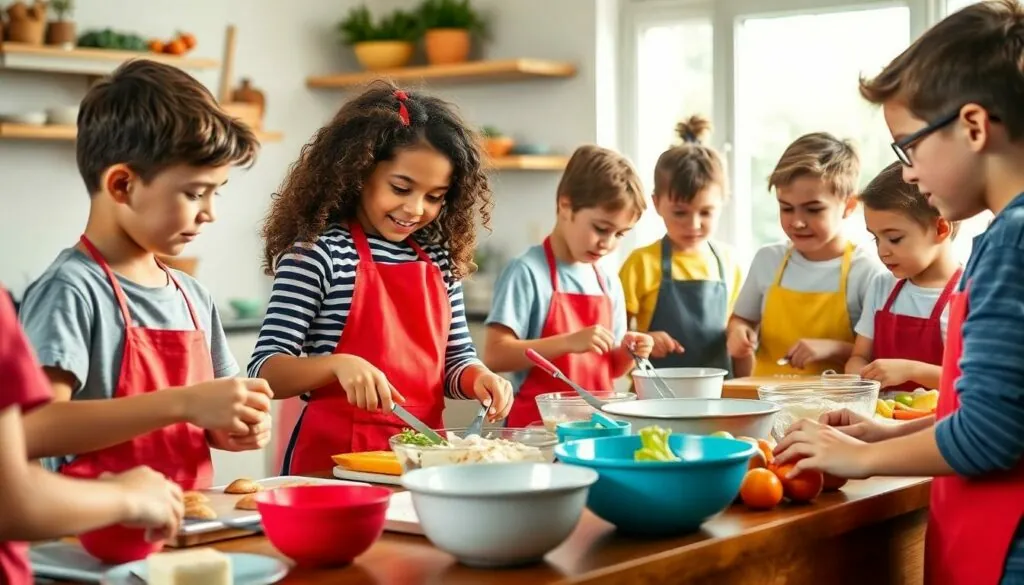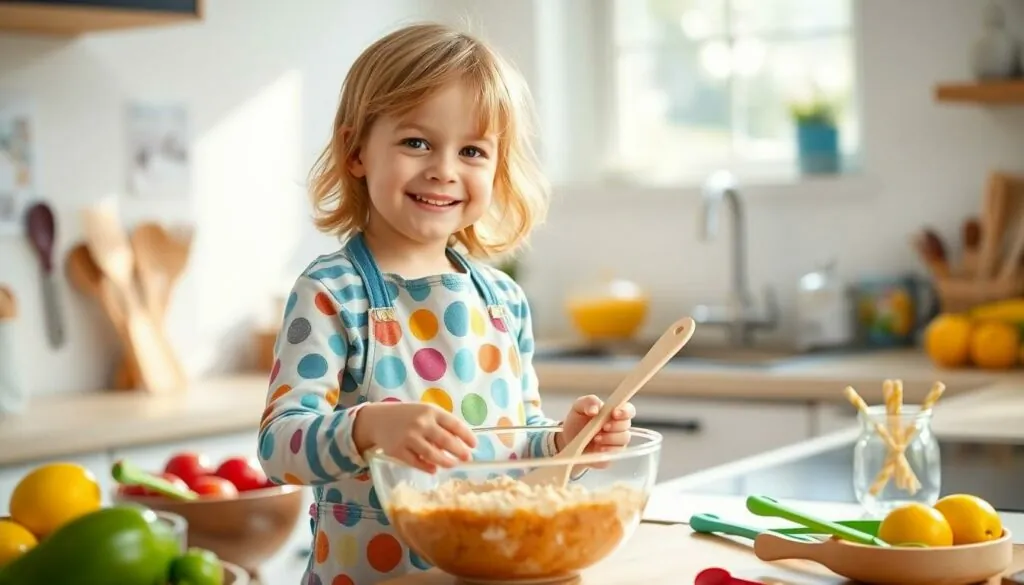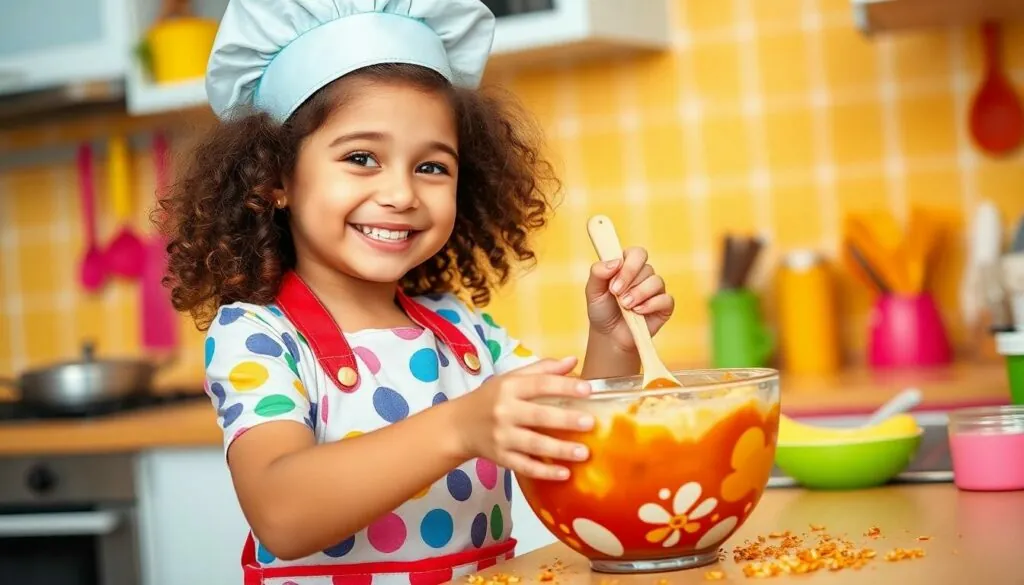Table of Contents
ToggleLooking for a way to transform your little ones into mini master chefs? Cooking camps for kids offer the perfect blend of fun culinary adventures and essential life skills. These hands-on programs teach children everything from kitchen safety to creating delicious recipes while making unforgettable memories.
From chopping vegetables to measuring ingredients these interactive camps help kids build confidence in the kitchen. They’ll learn about nutrition make new friends and discover the joy of creating meals from scratch. Plus they’ll bring home exciting recipes to surprise the family with their newfound cooking talents. Local cooking camps provide a safe supervised environment where young chefs can explore their creativity and develop a lifelong love for cooking.
Benefits of Kids’ Cooking Camps
Kids’ cooking camps create transformative experiences that equip children with valuable skills lasting far beyond their time in the kitchen.
Life Skills Development
Cooking camps empower children with essential life skills through hands-on culinary activities. Young participants master kitchen safety protocols including proper knife handling techniques proper food storage practices. These programs teach time management as kids learn to follow recipes coordinate multiple tasks simultaneously. Math skills improve naturally through measuring ingredients converting recipe quantities. Students develop responsibility by maintaining clean workstations organizing ingredients practicing food hygiene. The collaborative environment enhances communication skills as children work in teams share kitchen equipment coordinate meal preparation.
Creative Expression Through Food
Culinary camps unlock children’s artistic potential through food-based activities. Kids experiment with flavor combinations plate presentations color combinations to create unique dishes. The camps encourage innovation by letting children modify recipes add personal touches design original menu items. Young chefs learn plating techniques garnishing methods food styling approaches to transform ingredients into edible art. Students explore global cuisines cultural food traditions diverse cooking methods expanding their culinary horizons. The creative process builds confidence as children see their culinary visions transform into finished dishes they can share proudly.
Types of Local Cooking Camps
Local cooking camps offer diverse programs tailored to different schedules, skill levels and age groups. Each type provides unique learning experiences that match children’s developmental stages and interests.
Day Camps vs Overnight Programs
Day camps run from 9 AM to 4 PM, providing structured cooking activities during regular business hours. These programs allow children to return home each evening, making them ideal for families seeking flexible scheduling options. Overnight programs extend the culinary experience through multi-day immersive sessions lasting 3-14 days. Residential camps include accommodations, evening activities and opportunities to prepare three meals daily. Day camps cost $75-150 per day while overnight programs range from $800-2000 per week.
| Program Type | Duration | Daily Hours | Price Range |
|---|---|---|---|
| Day Camp | 1-5 days | 9 AM – 4 PM | $75-150/day |
| Overnight | 3-14 days | 24 hours | $800-2000/week |
Age-Appropriate Classes
Cooking camps segment children into specific age groups to ensure appropriate skill development. Classes for ages 5-7 focus on basic kitchen safety, simple recipes and fun food crafts. Groups ages 8-11 learn fundamental techniques like measuring, mixing and safe knife skills. Teen programs for ages 12-16 cover advanced cooking methods, meal planning and creative recipe development.
| Age Group | Focus Areas | Skills Taught |
|---|---|---|
| 5-7 years | Kitchen basics | Safety, simple recipes |
| 8-11 years | Fundamentals | Measuring, knife skills |
| 12-16 years | Advanced | Techniques, meal planning |
What to Look for in a Cooking Camp
Selecting the right cooking camp ensures children receive quality instruction in a safe environment. Parents evaluate several key factors when choosing a program that matches their child’s interests and skill level.
Safety and Supervision
Professional cooking camps maintain strict safety protocols with a low student-to-instructor ratio of 8:1 or less. Each kitchen station features age-appropriate equipment properly sized for young hands. Instructors hold current food safety certifications including ServSafe or equivalent credentials. The facility follows health department guidelines with clearly marked emergency exits visible first aid stations dedicated handwashing areas. Staff members receive background checks training in allergy management CPR certification. The kitchen space includes proper ventilation slip-resistant floors emergency shut-off switches for equipment.
Curriculum and Teaching Methods
Expert instructors use hands-on demonstrations interactive lessons recipe modifications to engage young chefs. The curriculum incorporates measuring techniques knife skills kitchen terminology food science principles. Classes progress from basic skills to advanced techniques matching each age group’s abilities. Students learn through structured activities:
- Recipe reading comprehension exercises
- Kitchen math practice with fractions measurements
- Food safety hygiene protocols
- International cuisine exploration
- Nutrition education seasonal ingredients
- Team cooking challenges competitions
- Food presentation plating techniques
The program adapts teaching methods based on learning styles incorporating visual aids hands-on practice group discussions.
Popular Cooking Camp Activities
Cooking camps engage children in diverse culinary activities designed to build essential skills while fostering creativity in the kitchen. Each activity combines educational elements with hands-on experience to create an immersive learning environment.
Basic Kitchen Skills
Young chefs start with fundamental kitchen techniques that form the foundation of culinary expertise. Children learn proper knife handling with safety-approved utensils tailored to their age group. The curriculum covers measuring ingredients using standard cups volumes teaspoons tablespoons while incorporating basic math skills. Campers practice equipment identification naming common kitchen tools mixers blenders food processors. Activities include proper hand washing techniques food storage guidelines workspace organization methods. Kids master essential cooking methods like sautéing stirring folding whisking. Each skill builds upon the previous one creating a comprehensive understanding of kitchen fundamentals.
Recipe Creation and Testing
Campers explore their culinary creativity through structured recipe development sessions. Students learn to modify existing recipes by adjusting ingredients quantities flavors. The testing process involves documenting changes recording outcomes evaluating results. Kids create recipe cards with detailed instructions ingredient lists cooking times temperatures. Taste testing sessions allow campers to provide constructive feedback on peer creations. Children experiment with ingredient substitutions to accommodate dietary restrictions create healthier alternatives. The process teaches scientific principles through observation documentation analysis of cooking results. Recipe development activities culminate in personalized cookbooks featuring tested approved dishes.
Finding the Right Camp in Your Area
Cooking camps operate in numerous locations across local communities. A thorough search reveals multiple options for aspiring young chefs to develop their culinary skills close to home.
Local Community Centers
Community centers offer accessible cooking camps with prices ranging from $45-85 per day. Recreation departments coordinate these programs in equipped teaching kitchens located at neighborhood facilities. YMCA branches host 5-day sessions throughout summer months featuring basic cooking instruction for children ages 6-14. Parks departments organize themed cooking workshops focusing on specific cuisines such as Italian pasta making or Asian stir-fry techniques. Local libraries partner with culinary instructors to provide free 2-hour cooking demonstrations on weekends. Community education programs extend year-round opportunities through after-school cooking classes.
Professional Culinary Schools
Professional cooking schools deliver structured camp experiences with certified chef instructors. These institutions maintain commercial-grade kitchens equipped with professional tools sized for young chefs. Leading culinary academies offer week-long immersive programs priced between $300-600. Le Cordon Bleu affiliated schools provide French cooking techniques in 3-day intensive workshops. The International Culinary Center creates specialized teen programs covering advanced skills like pastry arts. Johnson & Wales University hosts summer cooking academies incorporating food science experiments. Cooking school camps maintain strict 6:1 student-to-instructor ratios ensuring personalized attention.
Cost and Registration Details
Local cooking camps offer diverse pricing options based on program duration, facility type, and included materials. Registration processes vary by location with specific enrollment deadlines and requirements.
Pricing Structure
Standard day camp sessions range from $75-150 per day, including all ingredients, equipment, and take-home recipe collections. Half-day programs cost $45-85, covering 3-4 hours of instruction with morning or afternoon options. Weekly rates provide savings at $300-600 for full-day programs featuring comprehensive culinary education. Premium culinary school programs range from $800-2000 per week, offering professional kitchen access and certified chef instruction. Additional costs include:
- Registration fee: $25-50 per child
- Kitchen safety equipment kit: $35-75
- Daily meal ingredients: Included in base price
- Take-home chef coat and apron: $45-60
- Recipe book materials: $15-30
Financial Aid Options
Cooking camps provide multiple financial assistance programs to make culinary education accessible. Income-based scholarships cover 25-75% of program costs for qualifying families. Local organizations partner with camps to offer:
- Early registration discounts: 10-15% off
- Sibling enrollment savings: $50-100 per additional child
- Multi-week program discounts: 20% reduction for 2+ weeks
- Community center subsidies: $100-300 per session
- Payment plans: 3-6 month installment options
Grant programs through culinary associations provide full scholarships to 5-10 students per location each season. Need-based assistance applications open 3 months before camp sessions begin.
What to Pack for Cooking Camp
Preparing for cooking camp requires specific equipment to ensure safety, hygiene, and successful participation in culinary activities. A well-packed camp kit enables young chefs to focus on learning and creating delicious dishes.
Required Kitchen Tools
Each participant needs a basic set of kitchen tools for daily cooking activities:
- Measuring cups with standard US measurements
- Digital kitchen scale for precise ingredient portions
- Three mixing bowls in small, medium and large sizes
- Two cutting boards: one for produce, one for proteins
- Kitchen timer or stopwatch for tracking cooking times
- Reusable food storage containers for taking creations home
- Recipe notebook and pen for documenting techniques
- Labeled lunch bag or cooler for storing prepared meals
- Kitchen towels and washable dish cloths
- Zip-top bags in various sizes for ingredient storage
Safety Equipment
Safety gear protects young chefs during cooking activities:
- Two clean chef aprons for rotation during camp
- Closed-toe non-slip kitchen shoes
- Heat-resistant oven mitts rated for 450°F
- Hair nets or caps for food safety compliance
- Three pairs of cut-resistant gloves in proper size
- Safety goggles for chopping strong ingredients
- First aid kit with bandages and antiseptic wipes
- Reusable water bottle to stay hydrated
- Food handling gloves for sanitary preparation
- Personal hand sanitizer for additional hygiene
The safety equipment list aligns with professional kitchen standards while remaining appropriate for young chefs’ activities.
Conclusion
Cooking camps offer children an invaluable opportunity to develop essential life skills while discovering the joy of culinary arts. These programs provide structured learning environments where young chefs can explore their creativity build confidence and make lasting friendships. From community centers to professional culinary schools there’s a perfect cooking camp for every child’s interests and skill level.
Parents who invest in cooking camps give their children more than just kitchen skills. They’re providing an experience that cultivates responsibility creativity and teamwork. With proper research and consideration of factors like safety curriculum and cost families can find the ideal program that matches their child’s culinary aspirations and developmental needs.




